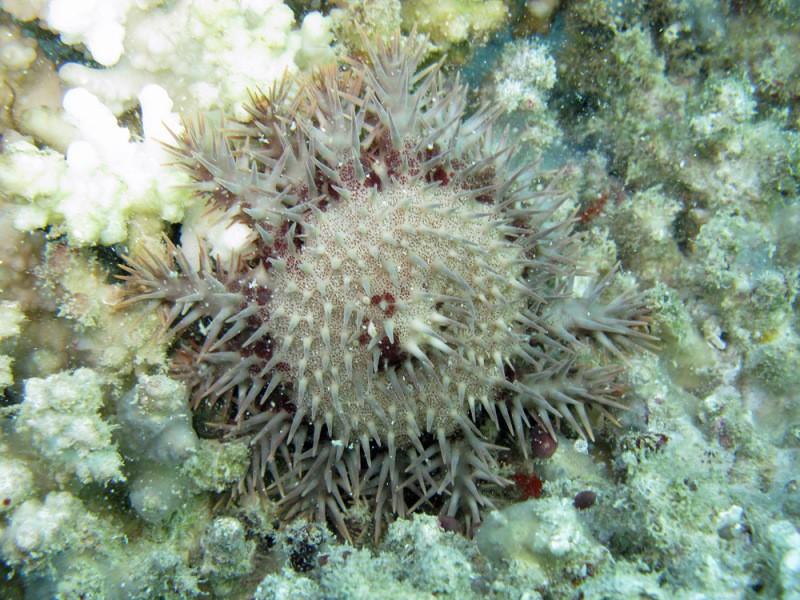
(Photo: Wikimedia Commons/Anne Hoggett)
A particular species of starfish has been harming the Great Barrier Reef. To save the reef, researchers suggest killing off these starfish.
Crown-Of-Thorns Starfish Destroys Coral Reefs
According to a new study, crown-of-thorns starfish destroy up to 108 square feet of corals yearly at the Great Barrier Reef. To help the reef recover, scientists recommend killing the starfish.
Crown-of-thorns starfish (COTS) are a large species of starfish named after their spiny appearance. They have 21 arms filled with poisonous spines that cause painful wounds and can grow up to 3 feet. They consume corals.
There have been multiple instances of COTS outbreaks on the Great Barrier Reef, and each instance tends to last over a decade - between 10 and 15 years. The first outbreak recorded happened in the 1960s, and it was deemed a major ecological threat because the COTS populations boomed. Their larval survival rates also increased due to the excess nutrients in the water.
Although COTS are a natural part of the marine system, they thrive due to nutrient runoff and the overfishing of their main predators. With its growing population and prevalence of mass coral bleaching, controlling COTS has become necessary to offset the lost corals and give the reefs enough time to adapt.
The researchers had already started killing some of the starfish on several parts of the reef. During dives, they injected the starfish with vinegar or ox bile, preventing the crown-of-thorn from releasing their larvae into the water. Between 2012 and 2022, the researchers had already culled the starfish across 500 of the 3,000 reefs across the Great Barrier Reef.
"COTS are voracious coral predators and are prone to rapid exponential increases in their populations size, known as outbreaks. These outbreaks of COTS can decimate reefs and entire regions of coral reefs and are responsible for about 40 percent of all coral losses on the Great Barrier Reef," said study co-author Samuel Matthews, a researcher at the Great Barrier Reef Marine Park Authority.
According to Matthews, their findings indicate they are most successful when they begin culling early in an outbreak when the amount of COTS is still low. It is also vital to cull on the most significant reefs for spreading COTS and coral larvae over the entire GBR. Focusing on these reefs can limit the spread of COTS outbreaks and aid faster coral recovery.
Matthews added that they might prevent significant coral loss from COTS in most of the GBR if they doubled the capacity of the control fleet (from 5-6 vessels to 10-12 vessels). However, it is important to remember that controlling COTS will only give the coral reefs more time to adapt to climate change and not necessarily solve their issue of dying reefs. In the coming years, more coral will bleach from bleaching if the current rate of global emissions continues.
ALSO READ: Chemical Compound in Sea Corals Show Potential for Effective Drugs Against Diseases Including Cancer
Coral Reefs' Condition
Another study found that 59 percent of reef sharks and rays were at risk of extinction. Their population has been depleted, and if they go extinct, it will negatively impact the reef as they are "key functional components of coral reef ecosystems."
However, in Australia, marine biologist Taryn Foster, who leads the effort to save the corals in the country, uses robots to speed up coral propagation. They grow replacement corals in the nursery and manually graft them onto existing reefs. The process is labor-intensive, expensive, and slow, as corals take three to 10 years to grow.
The team decides to use robots to help them deploy the corals at scale. Foster is developing two robotic arms with image sensors, collaborating with scientists at the Autodesk AI Lab in San Francisco. One may break coral fragments into smaller bits and glue them into plugs. The other can implant those plugs into the limestone skeletons.
Foster hopes to have several projects on reefs and coastlines around the world once the robots are operational, bringing about coral propagation much faster and on a larger scale.
RELATED ARTICLE: Robots Can Save Dying Coral Reefs in Australia; Biologists Developing Robotic Arms With Sensors for Propagation
Check out more news and information on Coral Reefs in Science Times.


![Some Brain-Injured Patients Who Died After Life Support Was Withdrawn May Have Survived, Recovered Some Level of Independence 6 Months After Injury [Study]](https://1721181113.rsc.cdn77.org/data/thumbs/full/53613/89/56/50/40/some-brain-injured-patients-who-died-after-life-support-was-withdrawn-may-have-survived-recovered-some-level-of-independence-6-months-after-injury-study.jpg)











